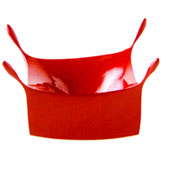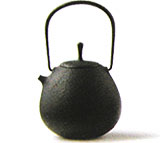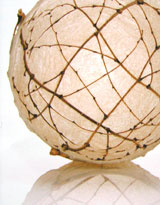|
|
 |
Generations upon generations of skilled craftsmen, thousands of years of tradition: these are what lie behind the beauty of Japanese crafts. Yet just as much as it can be an asset, tradition can be a handicap. Responding to the demanding eye of the connoisseur, the diligent craftsman pursues the ultimate in his or her craft, often to the point of over-refinement. In design, too, reliance on skill tends to take its toll on creativity.
Produced to show that tradition can indeed nourish creative modern craft design, Inspired Shapes features the work of 50 contemporary craftsmen who work with traditional materials ranging from metal and clay to vines and straw. The pieces were chosen by interior decor specialist Ori Koyama not just for their design but for some special quality that appealed to her. She mentions in the preface, for instance, how she was so mesmerized by a chair of smoked bamboo that her feet refused to move. It was made by a craftsman who came upon his vocation while in search of an unspoiled way of life. At a time when bamboo craft was rapidly losing its raison d'etre, he chose to apprentice himself to a bamboo craftsman without questioning the practicality of learning a dying craft. Such lack of interest in financial gain might be the secret behind the subtle attraction of his pieces. And that probably can be said about much of the work selected here.
Although many of the other artists represented in Inspired Shapes did start their career straight out of art school or vocational training, many others like the bamboo craftsman developed their talents after having finished other studies or after entering other careers. The maker of rice straw calligraphy brushes, for instance, developed her own style of brushes out of her interest in calligraphy, and the carver of katakuchi bowls used his weekends to teach himself how to carve and apply hand-rubbed lacquer. There are also those who came from traditional craft families. But no matter from what background, the craftsmen share one thing in common: a fascination with the possibilities of the material they are working with. As the brush maker says, "I don't know how long I can keep thinking up new shapes, but I'd like to try."
This search for novelty, however, must be balanced with the parameters of practical use. Some of the pieces, as visually stunning as they might be (and despite having in some cases received high awards), fall short of the high standards of beauty and use of former craftsmen. Some are too much like interior decoration; some are just too coy. Others, however, succeed eminently, like the stacked lacquered cups. Designed by an artist who studied first in Milan and then took up lacquer for its uniquely Japanese character, it incorporates the traditional bold colors of Akita lacquerware and the clever use of stacking that is traditional to Japan and in so doing has created a functional yet visually pleasing object. All of the elements that have always made Japanese crafts so outstanding are here. Those artists who have run off like a racehorse toward the prize of novelty need to reflect on what tradition has to teach. Their creativity is promising, however. Maybe like a good cheese, modern craft design sometimes needs time to ripen.
Patricia Massy
A resident of Japan for 40 years, Ms.Massy has personally visited hundreds of craftsmen throughout Japan. Besides her column on traditional crafts which ran in the Japan Times for nearly 20 years, she also has organized and conducted tours focusing on Japan's traditional crafts. She continues to write on Japanese crafts and culture while teaching at Kanto Gakuin University
|




